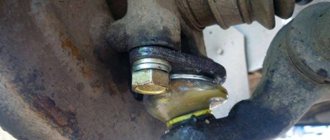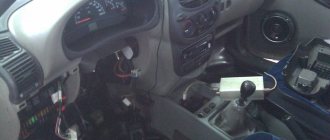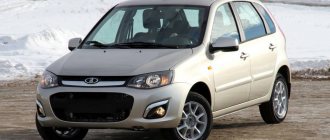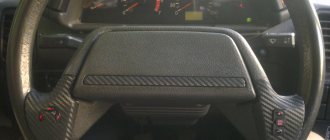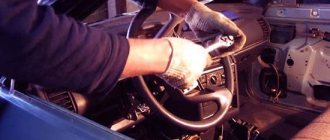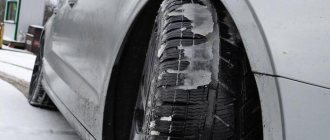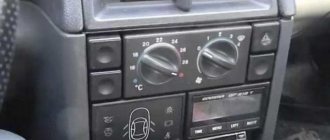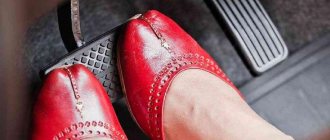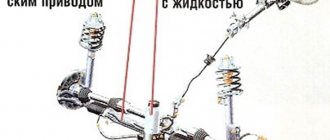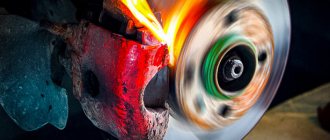The safety of the driver and passengers depends on the technical condition of the car. Minor structural damage that causes vibrations in the steering wheel when braking can lead to serious consequences. In most cases, the driver diagnoses the breakdown on his own or goes to a car service center.
The most likely cause of vibration is the condition of the brake discs. But this is not always the case. The culprit may be deformation of the steering racks or the formation of a hernia on one of the wheels.
Why does the steering wheel vibrate when braking?
Before self-diagnosis, you should think about what preceded the appearance of the beating. Has the chassis system been repaired or brake pads replaced? It is worth starting to identify the breakdown with replaced parts. They may be made from low quality materials.
It is also important to consider the experience of the technician who performed the repair. Failure to comply with installation technology leads to increased loads. Not only the replaced part suffers, but also the system as a whole.
Did the steering wheel wobble after driving through puddles or fresh snow? Pay attention to the condition of the brake discs. Temperature changes lead to surface deformation.
Does the steering wheel exhibit a large range of motion and become difficult to hold? With a 99% probability, the problem lies in broken brake discs or improper bleeding of the system. In such a situation, urgent repairs are necessary. The wheels react differently when you press the brake pedal. The likelihood of getting into an accident increases, and driving the car becomes uncomfortable even for an experienced driver.
Reasons for vibrations in the steering wheel:
- Wear of brake discs.
- Technical condition of the running system.
- Hernia or deformation of the wheels.
- Nuts not tightened tightly.
Before detecting deformation of the steering rod or wear of the brake disc, you should pay attention to the fastening of the wheels. In most cases, the cause of wobbling is not that they are poorly secured. But if the problem is just one loose nut, then it will be unpleasant to find out after a full repair.
Diagnosis of the malfunction and methods for its elimination
How to fix a problem like this? Drivers who believe that this defect is caused by defective parts of the brake system replace them. However, this approach is not always effective. Replacing spare parts does not help for long, so installing new parts to replace existing ones is a waste of money and time. Replacing supposedly defective parts is reminiscent of a situation where a patient with a severe cold tries to recover with just hot tea.
Experienced drivers recommend replacing all brake discs with new ones, and the new discs must be imported. The fact is that replacing existing disks with new domestic ones can only lead to aggravation of the problem. This is explained by the fact that the metal from which Russian discs are made is more “raw” in comparison with imported models, and therefore it wears out very quickly from contact with the brake pads. Road dust and sand play an important role in this process.
Sometimes, even installing high-quality imported disks does not allow achieving a positive result, since the root of the existing problem is located in a completely different place.
Car owners often face the problem of play and wobble in the steering wheel. Thus, vibration on the steering wheel of a VAZ 2110 is a fairly common phenomenon, observed more often at a speed of 90 km/h. The shaking increases more and more when driving exceeds 100 km/h, regardless of the road surface. Let's try to figure out in this article why vibrations occur on the steering wheel of the VAZ 2110?
How to detect wear on brake discs?
Before repairing, it is necessary to diagnose the breakdown.
Is it just the steering wheel that vibrates? The likely cause is wear of the front brake discs or the system as a whole. Has the brake pedal also changed its behavior? Pay attention to the rear braking system. The handbrake can be used to determine the malfunction. If the vibration stops when using it, then you should look for a problem in the front brake system. Is there any beat left? Examine the technical condition of the rear brake discs and the system as a whole. The procedure allows you to determine the location of deformed parts.
Next, you should test the wheels or study the appearance of the brake discs. Raise the car on a jack and remove it from gear. If the rear axle is suspected, then the handbrake must be lowered. Spin the wheel. Is the rotation uneven and changing intensity in the same place? The problem has been identified. If the test result is negative, move on to the next wheel.
The appearance of the brake disc says a lot about its technical condition. Noticed cracks, unevenness or chips? Replacement or grooving is required, depending on the situation. The presence of a bluish tint on the surface is a sign of overheating.
When inspecting, pay attention to the brake calipers. It's unlikely, but they can also cause vibrations in the steering wheel.
How to determine the cause
Before drawing any conclusions regarding why the steering wheel shakes when braking, you need to carefully examine all the components of the units. Perhaps the reason is more than clear. And you can make an approximate repair estimate yourself.
If the steering wheel shakes when braking, first of all we check the brake drums, discs and pads.
The disk must have a perfectly round, smooth surface. If they are deformed, “went in waves”, “bumps” have formed or are extremely worn out, it is worth considering why. The car owner could save on quality components and bought a fake from an unknown manufacturer. A very hot disk could get into a puddle or snow. Strong temperature changes are detrimental to metals. Or the driver applied emergency braking, and at that moment the pads left grooves or bent the disc. Previously overheated metal can be easily identified by its bluish tint.
The brake drum must also be perfectly round. It is worth considering that it is still more difficult to deform than a disk.
The pads must be intact and unworn. Check the condition of these mechanisms regularly.
How to determine wear of the chassis and other breakdowns?
Is the failure at the front, but the tested discs are in perfect condition? A visual inspection of the chassis system allows you to find a breakdown. Tie rods and ends are likely causes of steering wheel wobble.
It will be difficult for an inexperienced person to notice the deformation of the structure. But if you notice unnatural bends, then the reason for the vibrations becomes clear. In less severe cases, it is necessary to rely on inspection and evaluation of the system as a whole.
A herniated or deformed tire is easily detected visually even by an inexperienced driver. There shouldn't be any problems with this. If there is no visible damage, it will be useful to remove the wheel and examine the surface from the inside.
Why are vibrations in the steering wheel when braking dangerous?
In most cases, the breakdown does not require immediate repair. By eliminating emergency braking, the car can be used even for several years. But there is an increased load on the chassis system, it is important to realize this.
By refusing to make repairs, you may end up having to spend a lot of money in the future. An important aspect is the pleasure derived from driving a car. The vibration of the steering wheel does not allow you to fully enjoy the trip.
The optimal solution in this situation is to carry out repairs if funds are available. The problem does not require urgent replacement of parts. But by constantly postponing repairs, you reduce your comfort and increase its cost.
Video on the topic
Causes of steering wheel vibration. Steering wheel vibration occurs for many reasons. There are various symptoms that can help determine the cause of steering wheel vibration. The steering wheel can vibrate both at a certain speed and constantly. Steering wheel vibrations can occur when accelerating, driving and braking a car, as well as when the engine is simply idling. Steering wheel vibration at speed most often occurs due to unbalanced rotating masses. There may be different reasons for this phenomenon, which can also simultaneously complement each other. Vibration of the steering wheel may occur due to the disk becoming clogged with dirt. Some rim models are designed in such a way that dirt can accumulate in certain places and, when dried, create an unbalanced mass. The first thing to do when steering wheel vibration occurs is to wash all the wheels and make sure there is no dirt on them. Steering wheel vibration can occur if the wheel is poorly balanced. This problem can only be solved with the help of a tire service. If, after visiting a tire repair shop, vibration of the steering wheel appears when accelerating and driving the car, then we can confidently say that the reason for this is poor wheel balancing. Steering wheel beating can occur due to incorrect geometry of the wheel rim or tire. This can be caused by improper repair of a tire or wheel, or a strong impact, which, for example, causes “bumps” on the rubber. A wheel with such defects can be perfectly balanced, but wheel runout will still be present, creating dynamic loads on the suspension and steering wheel vibrations. Steering wheel vibrations can also be caused by incorrect wheel installation, or if the disk parameters do not match the parameters of the hub. A common mistake is not properly tightening wheel bolts or wheel nuts. Nuts or bolts with a tapered base must be tightened, alternating with the opposite ones, and only if the wheel is suspended. Vibration of the steering wheel during braking can also occur due to unbalanced masses of the wheel. But the main reason for steering wheel vibrations when braking a car is severe uneven wear of the brake pads or discs. This problem can be resolved by replacing the brake discs and pads with new ones. A cheaper way to eliminate this problem may be to groove the brake discs, if their design and size allow this. The cause of steering wheel vibration during acceleration, movement and braking may be deformation of the wheel hub or other load-bearing elements of the vehicle suspension. This problem can be diagnosed by measuring the runout of a wheel mounted on a car while it is rotating in a suspended state. Deformation of the wheel hubs is most often the result of hitting a speed bump or a large pothole at high speed. Steering wheel vibration at idle can occur for many reasons. The most common problem is a malfunction of the engine or gearbox mounts. This problem can be eliminated by replacing the supports that have failed. Vibrations in the steering wheel can occur when the engine is idling unstable. In this case, you should check the spark plugs. Vibration may occur in the steering wheel due to an imbalance or breakdown of the air conditioning fan. If the air conditioner radiator is clogged, then the air conditioning fan will constantly work at maximum speed, which can also cause steering wheel vibrations. Whatever the reason, steering wheel vibrations are not a normal phenomenon, but are a kind of “critical signal” to the driver about a car malfunction. If vibrations appear on the steering wheel, the cause should be immediately identified and eliminated.
Unusual causes of steering wheel knocking when driving
It's not just the suspension and steering that can cause knocking noise. Under the influence of shocks and sudden braking of the car, poorly secured components and mechanisms are displaced. Two metal surfaces hit each other, inevitably accompanied by ringing sounds.
- Single dull knock when starting to move.
You should check the engine or gearbox mounts, as well as the clutch driveshaft. It is possible that the engine tilted when starting off, hitting the side member. - Clunking sound when driving on uneven roads and when turning.
Check if the steering wheel knocks when braking. A knocking sound will indicate wear on the brake caliper guides. - Irregular impacts, felt mainly at low speeds when turning.
If the car is front-wheel drive, the differential is faulty.
Sometimes knocking when turning occurs due to unusual situations that are difficult to diagnose. For example, there was a case where a small stone hit the subframe and got stuck while the car was moving. When the car turned, the steering gear parts naturally shifted, running over this stone. When the wheels were aligned, the steering mechanism parts took their original position and at the same time jumped off the stone with a characteristic impact sound. The problem was eventually resolved by removing the stone from the subframe.
In other cases, when turning or driving in a straight line, the subframe itself knocks in the suspension. This is due to the loosening of the bolt, which must be tightened to eliminate the knocking.
Summarizing all of the above, we will give some tips for beginners.
To prevent the appearance of steering wheel knocks when driving and other extraneous noises, as well as the reasons for their occurrence, regularly service your car. Inspect it from all sides, including from below. Follow the speed limit and drive carefully. Only in these cases will extraneous noise in the car not disturb you over a long period of operation.
However, one day the moment comes when all kinds of hinges, supports and tips need to be changed. Unfortunately, each unit and mechanism has its own limited service life.
Wheel problems
It is precisely problems with stingrays that cause the mentioned phenomenon in most cases. Let's consider them in descending order, according to the possible likelihood of their occurrence.
In 70% of cases of runout during braking at speed, wheel imbalance is to blame. Failure to adjust the ramp leads to the appearance of centrifugal force - the heavier part of the wheel pulls its center towards itself. The result is body shaking with vibration transferred to the steering wheel. The loss of one or more weights is determined simply: the beating appears at speeds greater than 60 km/h and when braking from there. When eliminating a defect, it is important not to make a mistake: correct balancing is carried out not on the pair of wheels where its violation was noticed, but on all 4.
The next most common reason is defects in tires and wheels. Flying into a hole or lateral collision with a curb disrupts the geometry of the latter, and the slope gives vibration not only to the steering wheel, but throughout the entire body. In some cases, it will not be possible to detect curvature visually. However, you can jack up the car and turn the wheel. If it is loose, take it to a tire shop and have it checked at a stand. As for tires, the culprit may be a manufacturing defect that led to the formation of lumps, or perhaps road damage to the cord.
Next in line is low tire pressure. It rarely happens to those who watch their wheels, but even the most attentive driver can run into a stud along the way. It is worth checking the pressure in the slopes and pumping them up to normal - perhaps such simple actions will immediately remove the beating.
Poor tightening of wheel bolts is a primitive reason, but often overlooked and, moreover, the cause of many accidents. Please note that it is possible for the bolts to spontaneously loosen while driving, say, on a “washboard”.
In any case, when runout occurs during braking, especially at high speeds, the wheels are carefully inspected first. If you were unable to find a defective one, go to a tire shop and entrust the diagnostics to professionals.
Other reasons
They should be considered last, since they are the result of undetected problems with the ramps - if this concerns the chassis. However, problems with the brakes may also arise. Their diagnosis is carried out as soon as you have determined that the wheels have not failed you.
- Long-term driving with unbalanced wheels inevitably leads to damage to the wheel bearing, and in some cases, to other components that make up the suspension (steering rod, ball joint, etc.);
- Deformation of the brake disc or drum - depending on what type of brake your car has. Geometry distortions can be caused, firstly, by natural wear, secondly, by overheating due to prolonged braking, and thirdly, by a combination of the latter factor with water getting on the hot metal.
If the drum/disc is deformed, beating appears only when braking, and at any speed. Acceleration and uniform movement are not accompanied by shaking. Moreover, at first only vibration is observed when braking at high speed, and as the condition of the damaged unit worsens, it begins to accompany any pressing of the brake pedal. Discs and drums cannot be restored. If this sad case befalls you, the beating can only be eliminated by replacing them.
Identifying possible causes of knocking
Turning the steering wheel of front-wheel drive cars involves many joints, levers and rubber seals. A knocking sound in the steering wheel when turning may indicate wear of components or parts.
First of all, the assistant can turn the steering wheel, and you can listen to sounds under the car. Sometimes it is difficult to determine a breakdown by hearing, so you can touch various parts with your hand.
Wheel arch protection
One of the common causes of knocking is loosening of the wheel arch protection. In this case, it first turns under the action of the wheel, then returns to its original position, which gives rise to a characteristic “plastic” sound. Reliable fixation of the plastic protection takes a few minutes.
Hinges
Knocking when turning wheels can be generated by hinge joints: steering tips and rods, earrings and stabilizer rods. The noise occurs when a dirty or unlubricated joint jams. Sometimes it is enough to lubricate it, sometimes it is necessary to replace it.
https://youtube.com/watch?v=BH–BZCeXFc
A metallic crack that accompanies a full turn of the steering wheel may indicate a breakdown of the constant velocity joint, or in popular parlance, a “grenade”. A cracking sound when turning in both directions means that both “grenades” need to be replaced. Failure of CV joints is usually associated with a rupture of the rubber boot that protects the mechanism body. Even a small tear is enough to create the need to replace one of the most expensive components of the chassis. Therefore, it is better to check the anthers once a month for damage.
Silent blocks and ball joint
Noise can be caused by heavily worn-out rubber silent blocks and ball joints. In this case, when the wheels turn, the lever becomes skewed, which generates the sound.
Front pillar
If the steering wheel of a stationary car knocks when turning, then very often this means a breakdown of some part of the front strut. Some of these faults can be found directly, others can be found by dismantling and disassembling the rack.
Strut bearing
The stand is attached to the car body with two or three nuts. Its support is made of elastic materials that soften body vibrations. The stand rotates using a support bearing. A strong knock occurs when it jams due to deformation of the holder or lack of lubrication.
Strut spring
This spring is fixed by special rubber or plastic bumpers with cavities. When turning the wheels, the spring must remain motionless. If it is broken or comes out of its seats, a knocking noise occurs.
A knocking noise when turning occurs when the wheel bearing wears out. It is easy to diagnose such wear. You need to shorten the wheel on the sound side and check the axial play by rocking the wheel. If there is play, the bearing must be replaced, which requires appropriate equipment and knowledge. Often both bearings fail at the same time. This can be serious. The complexity of the repair here lies in the procedure of “pressing” the bearing out of its place in the hub. Such a diagnosis is fraught with long-term, expensive “treatment”, and failure to take action in a timely manner can lead to complete destruction of the front suspension.
Non-standard reasons
Often the sound is not caused by a faulty part, but by something completely different. For example, one car owner got it after a pebble flew onto the subframe of his car and got stuck there. The elements of the steering column ran over a pebble and jumped off it, generating a sound. After removing the pebble, it disappeared.
Another car owner's front arm, which was replaced after a suspension repair, began to hit the subframe when turning, which caused a knocking sound. In this case, it was enough to lift the subframe with a pry bar.
